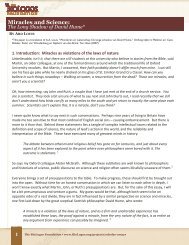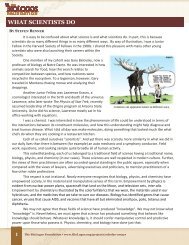The Biblical Creation in its Ancient Near Eastern Context - BioLogos
The Biblical Creation in its Ancient Near Eastern Context - BioLogos
The Biblical Creation in its Ancient Near Eastern Context - BioLogos
You also want an ePaper? Increase the reach of your titles
YUMPU automatically turns print PDFs into web optimized ePapers that Google loves.
<strong>The</strong> <strong>BioLogos</strong> Foundation • www.<strong>BioLogos</strong>.org/projects/scholar-essays<br />
it, there was God’s image. In other words, human be<strong>in</strong>gs are not only made <strong>in</strong> the image of God, but we<br />
are made as the image of God. In fact, it is possible to argue grammatically for the validity of the<br />
translation “as the image of God” as opposed to “<strong>in</strong> the image of God.” Prepositions are notoriously<br />
difficult to translate precisely from one language to another, and the Hebrew preposition here (the<br />
preposition be) has quite a large sphere of mean<strong>in</strong>g, but <strong>in</strong>cludes the sense of “as, or <strong>in</strong> the function of.” 8<br />
To put it another way, the Hebrew phraseology here denotes not so much the manner of the creation of<br />
the human be<strong>in</strong>g (i.e., the “mold” out of which humans are created), but rather the <strong>in</strong>tended function of<br />
the human be<strong>in</strong>g <strong>in</strong> the world. It is best to understand the statement <strong>in</strong> Genesis 1:26 as mean<strong>in</strong>g that<br />
human be<strong>in</strong>gs are fashioned <strong>in</strong> order to function as God’s image <strong>in</strong> the world. Humans aren’t just made <strong>in</strong><br />
God’s image; they are called to be his image <strong>in</strong> the world.<br />
Genesis 1:27 also explicitly says: “male and female he created them” –– male and female. This<br />
would also have been a radical thought <strong>in</strong> the ancient world. In the ancient <strong>Near</strong> East, essentially, if anyone<br />
was called the image of God it would have been the k<strong>in</strong>g. 9 For male and female –– that is, everyone –– to<br />
be the image of God, was a radical departure from conventional ways of th<strong>in</strong>k<strong>in</strong>g. In fact, the mention of<br />
male and female takes the idea further than that –– there’s a sense of <strong>in</strong>terdependence,<br />
<strong>in</strong>terconnectedness <strong>in</strong> terms of our capacity as human be<strong>in</strong>gs for reflect<strong>in</strong>g the image of God. I th<strong>in</strong>k this<br />
speaks not only to the dist<strong>in</strong>ctive characteristics of men vs. women per se, but really to the communal<br />
aspect of what it means to reflect God's character. In the biblical conception, there is a sense <strong>in</strong> which the<br />
community of human be<strong>in</strong>gs reflects God’s character, God’s glory, <strong>in</strong> a way that no s<strong>in</strong>gle <strong>in</strong>dividual is<br />
capable of do<strong>in</strong>g.<br />
Conclusion<br />
In conclusion: it is clear that the biblical account of creation, on the one hand, shows an awareness<br />
of the various literary motifs and symbols prevalent <strong>in</strong> other ancient accounts of ultimate orig<strong>in</strong>s. At the<br />
same time, Genesis 1 is <strong>its</strong> own creation (pardon the pun). By reconfigur<strong>in</strong>g those motifs and symbols, by<br />
putt<strong>in</strong>g them together <strong>in</strong> different ways, emphasiz<strong>in</strong>g certa<strong>in</strong> po<strong>in</strong>ts and mak<strong>in</strong>g others less prom<strong>in</strong>ent, the<br />
author of this story was able to put together a powerful theological statement about ultimate orig<strong>in</strong>s. In<br />
my observations today, I have only been able to articulate very broadly the k<strong>in</strong>d of <strong>in</strong>terpretation of<br />
Genesis 1 that I th<strong>in</strong>k takes seriously <strong>its</strong> situatedness <strong>in</strong> an ancient <strong>Near</strong> <strong>Eastern</strong> context. However, I also<br />
hope that I have been able to illustrate a broader <strong>in</strong>terpretive pr<strong>in</strong>ciple, that situatedness <strong>in</strong> a cultural<br />
environment does not imply an unimag<strong>in</strong>ative adoption of <strong>its</strong> conventionalized ideas. From time to time,<br />
biblical scholars and theologians speak of the Bible “borrow<strong>in</strong>g” motifs and themes from this or the other<br />
ancient <strong>Near</strong> <strong>Eastern</strong> literature. While there are <strong>in</strong>stances <strong>in</strong> which such a description is accurate, I th<strong>in</strong>k to<br />
use “borrow<strong>in</strong>g” as a default understand<strong>in</strong>g of this dynamic relationship fails to do justice to the creativity<br />
and brilliance of the biblical writers. What we f<strong>in</strong>d <strong>in</strong> the Bible <strong>in</strong> general, and <strong>in</strong> Genesis 1 <strong>in</strong> particular, is<br />
literary sophistication of the highest order, evidenced at times by the conscious re-shap<strong>in</strong>g of prevenient<br />
cultural ideas for uniquely theological purposes, and as Christians we would do well to attend to this aspect<br />
of the biblical text <strong>in</strong> our attempt to discern <strong>its</strong> message.<br />
5<br />
<strong>The</strong> <strong>Biblical</strong> <strong>Creation</strong> <strong>in</strong> <strong>its</strong> <strong>Ancient</strong> <strong>Near</strong> <strong>Eastern</strong> <strong>Context</strong><br />
BY JOSEPH LAM




